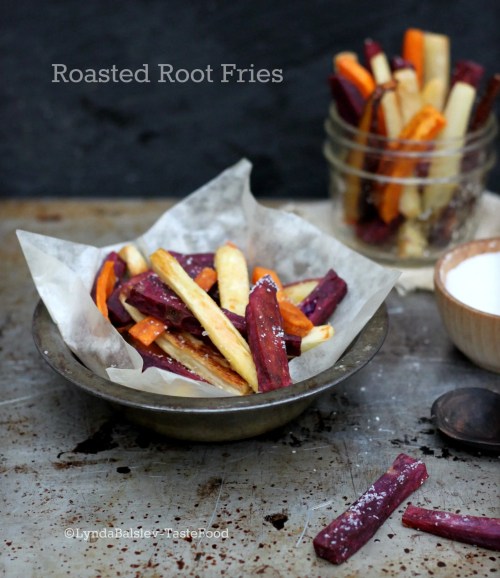If you have a hankering for fries, try these spiced and roasted root fries for a healthy alternative. Switch out the go-to potato for nutrient-rich roots and tubers, such as sweet potato, rutabaga, carrot, and turnip. Mix and match the selection to your taste, but go for a colorful array, guaranteed to brighten your dinner plate. Slow roasting them will coax out the natural sugars which will encourage browning and slight caramelization, without the added fat of deep frying. Serve with a cooling yogurt dip spiked with Sriracha – not too heavy, low in fat, big on flavor. So, go on and indulge in this healthy winter snack and consider it a virtuous start to the new year.
Roasted Root Vegetable Fries
Leave the skin on the baked potato for extra nutrients and texture. If you can get your hands on purple sweet potatoes, give them a try – they maintain their firmness during roasting which makes for a great fry.
Serves 4 to 6
2 1/2 pounds assorted root vegetables, such as sweet potato, rutabaga, carrot, parsnip
2 tablespoons olive oil
2 teaspoons salt, or to taste
1 teaspoon ground cumin
1/2 teaspoon sweet paprika
1/2 teaspoon freshly ground black pepper
Sriracha Yogurt Dipping Sauce:
1 cup Greek whole milk yogurt
1 small garlic clove, minced
1 tablespoon Sriracha
1/2 teaspoon salt
1/4 teaspoon freshly ground black pepper
Heat the oven to 425°F. Cut the root vegetables into 2-inch batons, about 3/8-inch thick. Place in a large bowl. This the oil, salt, cumin, paprika, and pepper in a small bowl. Pour over the vegetables and stir to evenly coat.
Spread the vegetables in one layer on a large rimmed baking sheet. Bake on the lowest rack of the oven until browned on the bottom, 20 to 25 minutes. Move the baking sheet to the top rack of the oven and bake until golden brown on top and tender but not limp, about 20 minutes.
While the vegetables are roasting, whisk the dipping sauce ingredients in a small bowl. Serve the fries with the sauce for dipping.










